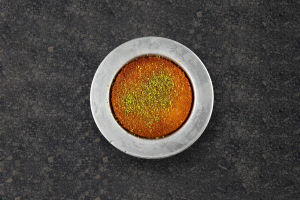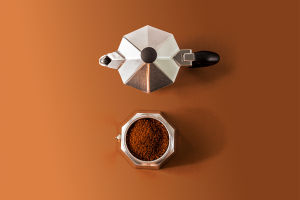
Turkish desserts are a hidden treasure, and they're more than just baklava or Turkish delight.
What many might not know is that traditional Turkish sweets are made from natural ingredients, offering not only delicious flavors but also health benefits.
Whether they're made with fruits, nuts, or dairy, these traditional treats have been enjoyed for centuries.
If you've ever thought about diving into the world of Turkish desserts, you're in for a treat! Today, we'll explore five of the most popular and healthy Turkish desserts you can make at home, complete with recipes to try out. So, Lykkers, get ready to satisfy your sweet tooth and learn a little history behind these iconic sweets.
1. Quince & Pumpkin Desserts: Traditional Simplicity
Quince dessert, or Ayva Tatlisi, has deep roots in Ottoman cuisine, especially linked to the city of Bursa, which played a key role in shaping Ottoman court cuisine. This fruit-based dessert is loved for its natural sweetness and is typically served with clotted cream (kaymak) and crushed walnuts.
Pumpkin dessert, or Kabak Tatlisi, is another naturally sweet Turkish treat. Particularly popular in the Aegean and Marmara regions, it's often paired with tahini and walnuts, adding both nutritional value and flavor.
Ingredients:
• 2 quinces (for Ayva Tatlisi) or 500 grams of pumpkin (for Kabak Tatlisi)
• 1 cup sugar
• 1 cup water
• Optional: Cloves, cinnamon stick
• Toppings: Clotted cream or fresh cream, crushed walnuts
Instructions:
1. Peel and halve the quinces (or cut the pumpkin into chunks) and remove the seeds, saving some of the quince seeds.
2. Place the fruit in a pot, sprinkle with sugar, and add water. Optionally, add some of the quince seeds, cloves, or a cinnamon stick for extra flavor.
3. Cover and simmer on low heat for 45 minutes to 1 hour, until the fruit softens. Quinces should turn a reddish hue.
4. Allow to cool before serving. Top with clotted cream or fresh cream and sprinkle with crushed walnuts.
2. Aşure (Noah's Pudding): A Classic Turkish Delight
Aşure, also known as Noah's pudding, is one of the oldest Turkish desserts. Its origins are tied to the story of Noah's Ark, where grains, beans, and dried fruits were mixed together to make a nourishing dish. In Turkish culture, Aşure symbolizes unity and generosity, especially during the first month of the Hijri calendar, when it is made and shared with neighbors.
This dessert has a special place not only in Turkey but also in many other countries like Greece, Armenia, Lebanon, and the Balkans. Every culture has its own version, usually made with grains, beans, and dried fruits, symbolizing abundance and togetherness.
Ingredients:
• 1 cup wheat kernels (or barley)
• ½ cup cooked chickpeas
• ½ cup cooked white beans
• ½ cup dried apricots, chopped
• ½ cup raisins
• ½ cup dried figs, chopped
• 1 apple, peeled and chopped
• 1 cup sugar (adjust to taste)
• 8 cups water
• Toppings: Pomegranate seeds, chopped nuts, cinnamon
Instructions:
1. Soak the wheat kernels overnight and drain.
2. In a large pot, combine the soaked wheat with 8 cups of water and cook on low heat until soft.
3. Add the cooked chickpeas, white beans, and dried fruits. Continue simmering until the mixture thickens.
4. Stir in sugar and chopped apple, and cook for a few more minutes.
5. Pour into bowls, cool, and top with pomegranate seeds, chopped nuts, and a sprinkle of cinnamon.
3. Nutty Delights and Carrot Dessert: A Healthy Treat
Nutty delights, or Sucuk Lokum, have been part of Turkish confectionery for centuries. Unlike the traditional Turkish delight (lokum), these have a soft and chewy texture with high sugar content, typically made by threading nuts together and dipping them in a thick fruit syrup, offering an energy-boosting snack.
Carrot dessert, or Cezerye, hails from Mersin and gets its name from the Arabic word “jazari” meaning carrot. Made with caramelized grated carrots, sugar, and nuts, it's a rich source of vitamins and fiber, making it a popular and healthy snack.
Ingredients:
• 3 large carrots, grated
• ½ cup sugar
• ½ teaspoon cinnamon
• ½ teaspoon clove powder (optional)
• ½ cup chopped walnuts or hazelnuts
• ½ cup shredded coconut (for coating)
Instructions:
1. In a skillet, cook the grated carrots and sugar over low heat for about 15 minutes until soft and caramelized.
2. Add cinnamon, clove powder, and chopped nuts, stirring well. Cook for an additional 5 minutes.
3. Remove from heat and let it cool slightly. Roll the mixture into small balls or form it into logs.
4. Coat with shredded coconut and allow to set before serving.
4. Milk Semolina Halva: A Comforting Dessert
Semolina halva, or Irmik Helvasi, is a classic Turkish dessert with Ottoman roots. It's typically made for special occasions, spiritual holidays, and gatherings. The milk version adds a richer flavor, balancing the light and nutty taste with a smooth texture.
Semolina halva holds a special place in Turkish culture, especially during mourning periods. Traditionally, it's made and served to comfort the grieving, symbolizing the fleeting nature of life and offering solace.
Ingredients:
• 1 cup semolina
• 1 cup sugar
• 2 cups milk
• ½ cup butter
• Optional: Pine nuts or chopped nuts
Instructions:
1. In a pan, melt the butter. If using nuts, add them and sauté until golden brown.
2. Stir in semolina and roast until golden.
3. In another pot, heat the milk and dissolve the sugar.
4. Gradually add the sweetened milk to the semolina mixture, stirring to avoid lumps.
5. Lower the heat and stir until thickened. Let it sit for 10 minutes before serving.
5. Tahini Walnut Delight: A Flavorful Sweet
Tahini walnut delight, or Nevzine, is a traditional Ottoman dessert known for its unique syrup made from sugar and glucose syrup. It originated in Kayseri, and in 2021, “Kayseri Nevzine” was officially registered as a geographical indication by the Turkish Patent and Trademark Office.
Ingredients:
• 2 ½ cups all-purpose flour
• 1 cup tahini
• 1 cup chopped walnuts
• 1 cup melted butter
• ½ cup yogurt
• 1 teaspoon baking powder
Syrup:
• 1 cup water
• 1 cup sugar
• ½ cup glucose syrup
• 1 tablespoon lemon juice
Instructions:
1. Preheat the oven to 350°F (180°C).
2. In a bowl, mix the butter, yogurt, tahini, and baking powder.
3. Gradually add the flour, kneading into a thick dough. Incorporate the chopped walnuts.
4. Press the dough into a greased baking pan and score it into squares or diamonds.
5. Bake for 30-35 minutes, or until golden brown.
6. While baking, prepare the syrup by boiling water, sugar, glucose syrup, and lemon juice. Let it cool slightly.
7. Once the dessert is baked, pour the warm syrup over it and let it soak in. Cool completely before cutting into pieces.
Turkish desserts offer so much more than just sweetness—they carry history, culture, and stories that have been passed down through generations. From the communal sharing of Aşure to the comforting presence of semolina halva during times of mourning, these desserts bring people together in meaningful ways. Lykkers, by trying these recipes at home, you not only taste the flavors of Turkey but also the rich traditions behind each dish.


